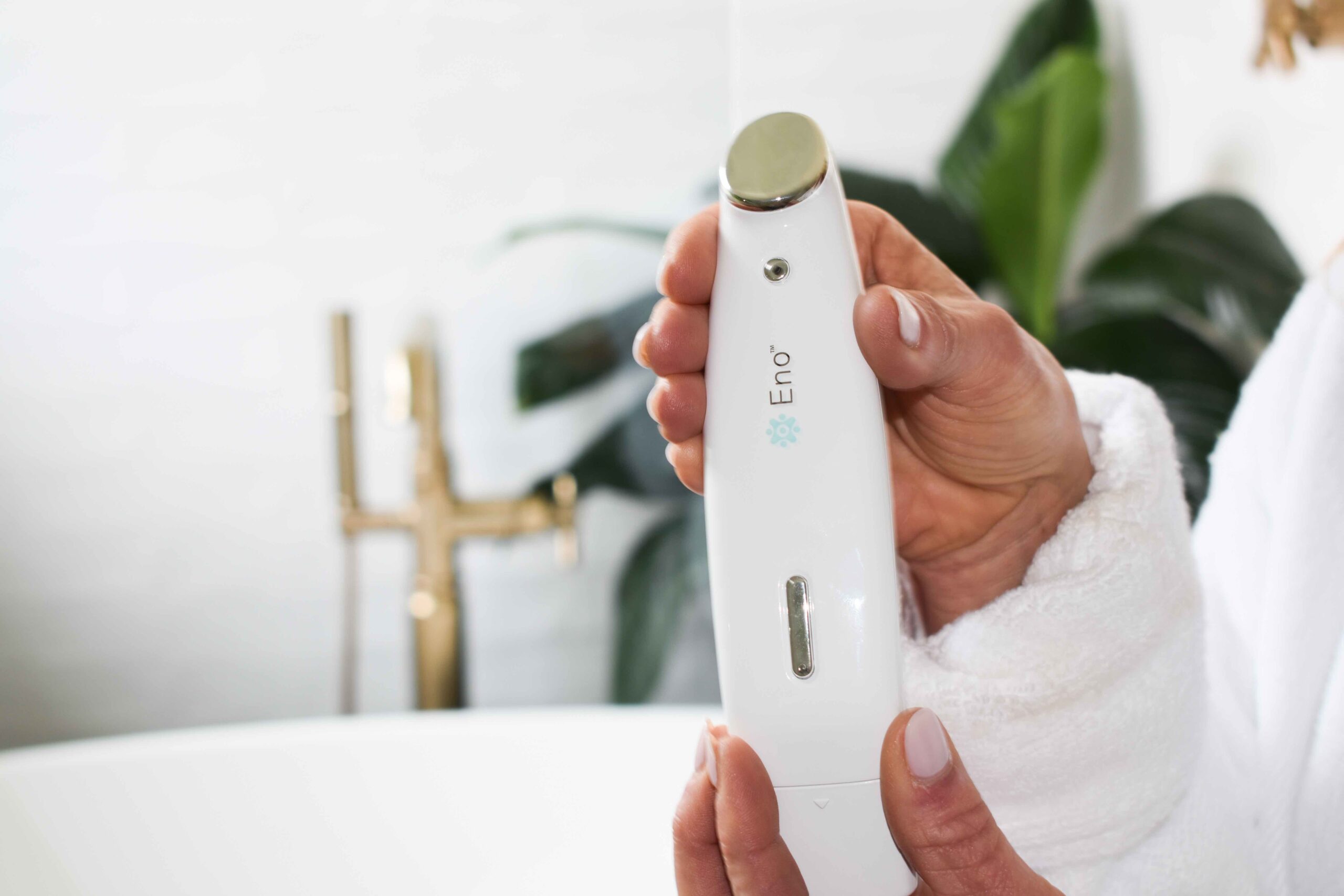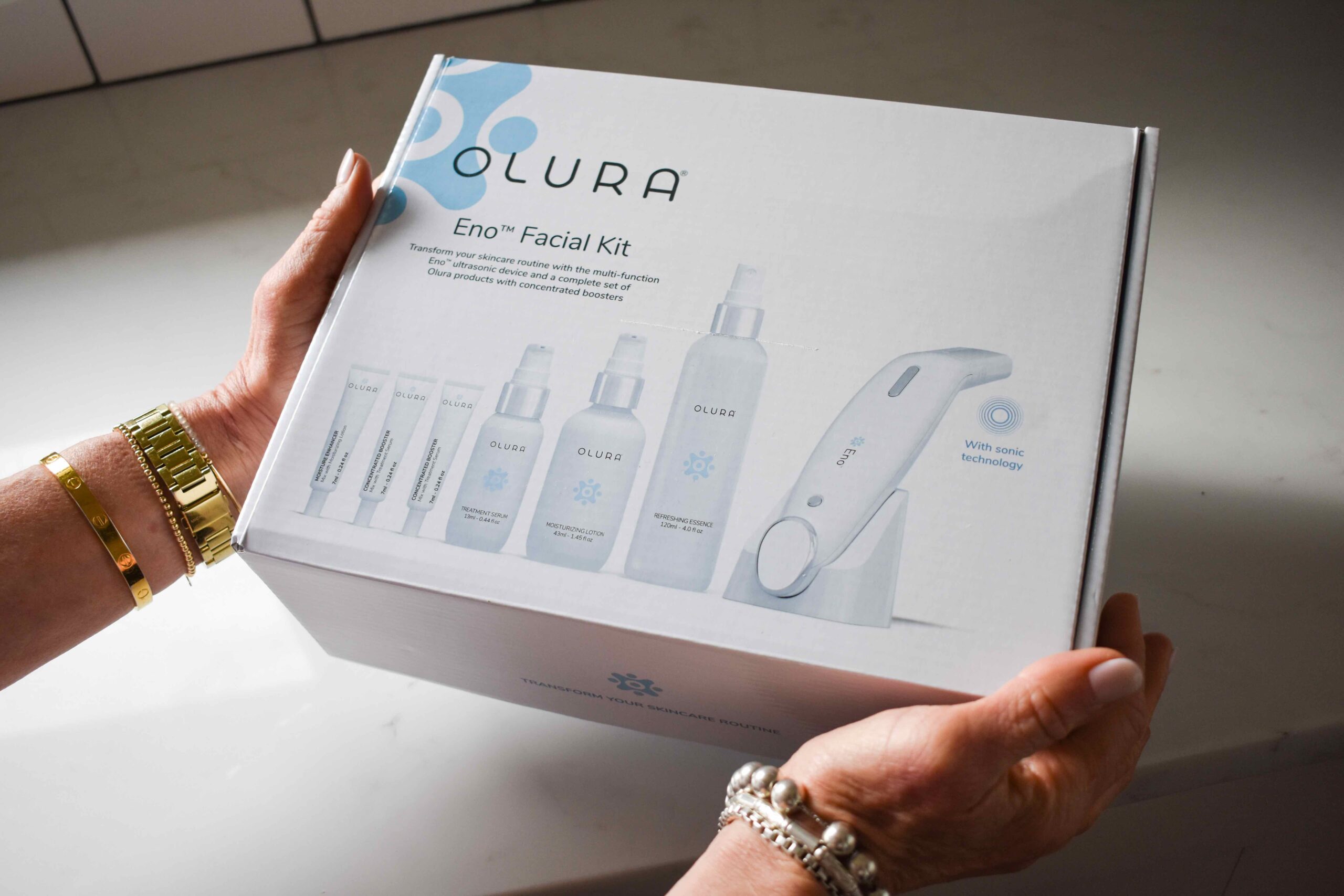After the coronavirus pandemic hit last year, consumers skipped services at their local spas and dermatologist offices, and transformed their bathrooms into skincare sanctuaries with newfangled products and devices. Olura’s co-founders and its investors don’t think consumers are giving up their high-tech at-home routines for the foreseeable future.
The brand has launched with an ultrasonic-powered dual-sided device it calls Eno that acts as an exfoliator to slough off dead skin cells, even skin tone and boost skincare absorption, and an infuser and sculptor to firm and contour skin tissue. Created with designer Klaus Rosburg to be elegant and easy to hold, the device is coupled with skincare products Olura describes as “cleanical” that its customers can customize to suit their needs and preferences. On a subscription basis, the brand sells a set with Eno and six topical skincare items for $245 and, after the initial purchase of the set, the topical skincare items are shipped every other month for $79. On a single-purchase basis, the set is $285.
Today, Kyoko Getz, an aesthetician, product developer and founding partner at Kate Somerville who started Olura with plastic surgeon Shirley Madhere and device authority Shannon Britt, former CEO and founder of Ageless Aesthetics and Novion Devices, says, “Some people are not comfortable going out to get a treatment and also some people may not be able to afford a treatment right in this confusing time. To me, it’s a great opportunity for us. You can treat yourself and take your time to do your own professional-grade treatment at home.”
 Olura has launched with an ultrasonic-powered dual-sided device it calls Eno that acts as an exfoliator to slough off dead skin cells, even skin tone and boost skincare absorption, and an infuser and sculptor to firm and contour skin tissue.
Olura has launched with an ultrasonic-powered dual-sided device it calls Eno that acts as an exfoliator to slough off dead skin cells, even skin tone and boost skincare absorption, and an infuser and sculptor to firm and contour skin tissue.
It took Olura three to four years to perfect Eno, according to Britt, and nearly as long to finish its debut products. The brand’s product lineup includes Refreshing Essence with the hydrators glycerin and glycogen, and antioxidant trehalose; Treatment Serum featuring niacinamide and peptides along with two boosters that can be added in to deliver a firming or age management lift; and Moisturizing Lotion with niacinamide as well that can be mixed with a moisture enhancement booster. Britt says Olura will increase its skincare product portfolio to enable customers to tailor their regimens as much as they’d like, and another device is expected to be released within 18 months.
Britt emphasizes quick results—he estimates customers can detect results from Eno in five to 10 minutes rather than perhaps four to six weeks with blue light devices—and ongoing guidance Olura offers subscribers from consultants will be crucial to its success in a device category he acknowledges is tricky. “Ultrasonic is so versatile because you can use it over acne,” says Britt. “We chose it because it’s effective and safe for a variety of skin.”
L’Oréal’s closure of Clarisonic last year illustrates the skincare device category’s difficulties. Despite the difficulties, it’s a category poised for expansion. Prescient & Strategic Intelligence projects sales of skincare devices globally will advance at a compound annual growth rate of 11% from 2019 to 2030 to reach roughly $2.8 billion. Olura forecasts it will generate $2.5 million in first-year sales.
“We want to be a personal fitness trainer for your skin.”
“I have a unique perspective because I’ve developed devices for product brands. We have had devices that were really well-accepted in the marketplace and, then, product companies lose their appetite for the device because it’s not a consumable, and requires support and training they aren’t accustomed to. That’s one of the things that pushed me to work with Kyoko and Dr. Madhere,” he says. “There’s just something about devices that don’t mesh well with product companies’ business models. I wasn’t surprised by what happened with L’Oréal and Clarisonic.”
Elaborating on the consultation Olura provides, Getz says, “I can come up with personal protocols for clients. That’s our passion. We do have amazing products. We do have an amazing device. But, also, we want to be a personal fitness trainer for your skin. We want to differentiate ourselves in that way. We want to pair the device with support so people stick to it.”
Britt explains part of the reason it took a while for Olura to launch was “the idea of raising capital was a daunting process.” The brand endured the daunting process and raised $1 million from Tina Hodges, Max Speyer and Patrick Conroy, investors in the Nashville area, where Britt lives, and Bill and Jeffrey Smith, co-founders of Shipt, which was sold to Target in 2017 for $550 million. Britt says, “Once we sat down with people and were able to talk about this concept and our experience, and show them how passionate we are about it, they invested in us as founders. Once we could get to that level, we were surprised by how easy it was.”
 On a subscription basis, Olura sells a set with Eno and six topical skincare items for $245 and, after the initial purchase of the set, the topical skincare items are shipped every other month for $79. On a single-purchase basis, the set is $285.
On a subscription basis, Olura sells a set with Eno and six topical skincare items for $245 and, after the initial purchase of the set, the topical skincare items are shipped every other month for $79. On a single-purchase basis, the set is $285.
A substantial portion of the funding will go toward marketing to acquire customers. Olura is honing a multi-pronged approach across Facebook, Instagram, Google and more platforms. Britt says, “We are attempting to build a community of evangelists who can see the benefits of what we are doing and talk about them.” He continues Olura is targeting consumers highly educated about skincare. They’re early to try skincare innovations and, under normal circumstances, they’d be paying for regular facials.
The professional spa channel will be important for Olura’s distribution. In the next year to 18 months, Britt anticipates the brand reaching out to retailers. He mentions Olura can shape sets focused on specific skincare concerns—acne, for example—that could be a fit for retail environments.
Discussing the appeal of Eno to consumers and retailers, Britt says, “It’s a tool you can use in a complete turnkey situation. No matter if you’ve got acne, if you’ve got wrinkles, if you’ve got drooping skin, it’s one piece of technology that can treat all of those things. We have a patent on the device, and there’s nothing else on the market like it.”
Source link : https://www.beautyindependent.com/olura-launches-multifaceted-skincare-device-raises-1-million-support-growth












